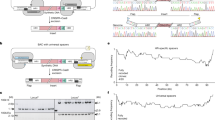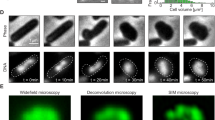Abstract
Bacterial artificial chromosome (BAC) libraries are the large DNA insert libraries of choice and valuable tools for the map-based cloning of target quantitative trait loci, physical mapping, molecular cytogenetics and comparative genomics. The protocol reported here is a simplified method used to produce and screen BAC libraries from Brachypodium species and other related grasses. Intact nuclei, containing high molecular weight (HMW) DNA, are isolated and embedded in agarose plugs. The HMW DNA is digested using an appropriate restriction enzyme and size-fractionated using pulsed-field gel electrophoresis. The DNA is isolated by dialysis, ligated into pre-prepared vector and electroporated into competent Escherichia coli cells. A PCR-based method for screening the library is also described. The entire protocol takes at least 6 weeks to complete.
This is a preview of subscription content, access via your institution
Access options
Subscribe to this journal
Receive 12 print issues and online access
$259.00 per year
only $21.58 per issue
Buy this article
- Purchase on SpringerLink
- Instant access to full article PDF
Prices may be subject to local taxes which are calculated during checkout







Similar content being viewed by others
References
Shizuya, H. et al. Cloning and stable maintenance of 300-kilobase-pair fragments of human DNA in Escherichia coli using an F-factor-based vector. Proc. Natl. Acad. Sci. USA 89, 8794–8797 (1992).
Woo, S.S., Jiang, J., Gill, B.S., Paterson, A.H. & Wing, R.A. Construction and characterization of a bacterial artificial chromosome library of Sorghum bicolor . Nucleic Acids Res. 22, 4922–4931 (1994).
Zhang, H.B. & Wu, C. BAC as tools for genome sequencing. Plant Physiol. Biochem. 39, 195–209 (2001).
Draper, J. et al. Brachypodium distachyon. A new model system for functional genomics in grasses. Plant Physiol. 127, 1539–1555 (2001).
Christiansen, P., Andersen, C.H., Didion, T., Folling, M. & Nielsen, K.K. A rapid and efficient transformation protocol for the grass Brachypodium distachyon . Plant Cell Rep. 23, 751–758 (2005).
Vogel, J.P., Garvin, D.F., Leong, O.M. & Hayden, D.M. Agrobacterium-mediated transformation and inbred line development in the model grass Brachypodium distachyon . Plant Cell Tissue Organ Cult. 85, 199–211 (2006).
Vogel, J.P. et al. EST sequencing and phylogenetic analysis of the model grass Brachypodium distachyon . Theor. Appl. Genet. 113, 186–195 (2006).
Hasterok, R., Dulawa, J., Jenkins, G., Leggett, M. & Langdon, T. Multi-substrate chromosome preparations for high throughput comparative FISH. BMC Biotechnol. 6, 20–24 (2006).
Jenkins, G. & Hasterok, R. BAC 'landing' on chromosomes of Brachypodium distachyon for comparative genome alignment. Nat. Protoc. 2, 88–98 (2007).
Engvild, K.C. Mutagenesis of the model grass Brachypodium distachyon with sodium azide. Risø Report R-1510 http://www.risoe.dk/rispubl/BIO/ris-r-1510.htm (2005).
Hasterok, R. et al. Alignment of the genomes of Brachypodium distachyon and temperate cereals and grasses using BAC landing with fluorescent in situ hybridization. Genetics 173, 349–362 (2006).
Farrar, K. et al. Construction of two Lolium perenne BAC libraries and identification of BACs containing candidate genes for disease resistance and forage quality. Mol. Breed. 19, 15–23 (2006).
Donnison, I.S. et al. Construction of a Festuca pratensis BAC library for map-based cloning in Festulolium substitution lines. Theor. Appl. Genet. 110, 846–851 (2005).
Calderini, O. et al. Molecular cytogenetics and DNA sequence analysis of an apomixis-linked BAC in Paspalum simplex reveal a non pericentromere location and partial microcolinearity with rice. Theor. Appl. Genet. 112, 1179–1191 (2006).
Zhang, H.B., Zhao, X.P., Ding, X.L., Paterson, A.H. & Wing, R.A. Preparation of megabase-size DNA from plant nuclei. Plant J. 7, 175–184 (1995).
Huo, N. et al. Construction and characterization of two BAC libraries from Brachypodium distachyon, a new model for grass genomics. Genome 49, 1099–1108 (2006).
Foote, T., Griffiths, S., Allouis, S. & Moore, G. Construction and analysis of a BAC library in the grass Brachypodium sylviticum: its use as a tool to bridge the gap between rice and wheat in elucidating gene content. Funct. Integr. Genomics 4, 26–33 (2004).
Chalhoub, B., Belcram, H. & Caboche, M. Efficient cloning of plant genomes into bacterial artificial chromosome (BAC) libraries with larger and more uniform insert size. Plant Biotech. J. 2, 181–188 (2004).
Peterson, D.G., Tomkins, J.P., Frisch, D.A., Wing, R.A. & Paterson, A.H. Construction of plant bacterial artificial chromosome (BAC) libraries: an illustrated guide 2nd Edition. (2002) http://www.mgel.msstate.edu/pubs/bacman2.pdf.
Kim, U.J. et al. Construction and characterization of a human bacterial artificial chromosome library. Genomics 34, 213–218 (1996).
Frengen, E. et al. A modular, positive selection bacterial artificial chromosome vector with multiple cloning sites. Genomics 58, 250–253 (1999).
Wild, J., Hradecna, Z. & Szybalski, W. Conditionally amplifiable BACs: switching from single-copy to high-copy vectors and genomic clones. Genome 12, 1434–1444 (2007).
Hamilton, C.M., Frary, A., Lewis, C. & Tanksley, S.D. Stable transfer of intact high molecular weight DNA into plant chromosomes. Proc. Natl. Acad. Sci. USA 93, 9975–9979 (1996).
Takken, F.L. et al. A one-step method to convert vectors into binary vectors suited for Agrobacterium-mediated transformation. Curr. Genet. 45, 242–248 (2004).
Chang, Y.-L., Henriquez, X., Preuss, D., Copenhaver, G.P. & Zhang, H.-B. A plant-transformation-competent BIBAC library from the Arabidopsis thaliana Landsberg ecotype for functional and comparative genomics. Theor. Appl. Genet. 106, 269–276 (2003).
Song, J., Bradeen, J.M., Naess, S.K., Helgeson, J.P. & Jiang, J. BIBAC and TAC clones containing potato genomic DNA fragments larger than 100 kb are not stable in Agrobacterium . Theor. Appl. Genet. 107, 958–964 (2003).
She, K. So you want to work with giants: the BAC vector. BioTech. J. 1, 69–74 (2003).
Sheng, Y., Mancino, V. & Birren, B. Transformation of Escherichia coli with large DNA molecules by electroporation. Nucleic Acids Res. 23, 1990–1996 (1995).
Bennett, M.D. & Leitch, I.J. Nuclear DNA amounts in angiosperms: progress, problems and prospects. Ann. Bot. (Lond.) 95, 45–90 (2005).
Southern, E. Southern blotting. Nat. Protoc. 1, 518–525 (2006).
Sambrook, J. & Russel, D.W. Molecular Cloning: A Laboratory Manual. (Cold Spring Harbor Laboratory Press, Cold Spring Harbor, New York, 2001).
O'Sullivan, D.M., Ripoll, P.J., Rodgers, M. & Edwards, K.J. A maize bacterial artificial chromosome (BAC) library from the European flint inbred line F2 . Theor. Appl. Genet. 103, 425–432 (2001).
Whatling, C.A. & Thomas, C.M. Pre electrophoresis of agarose plugs containing bacterial chromosomal DNA prepared for analysis by pulsed field gel electrophoresis can improve the clarity of restriction patterns. Anal. Biochem. 210, 98–101 (1993).
Ma, Z., Song, W., Sharp, P.J. & Liu, C. Non-gridded library: a new approach for BAC (bacterial artificial chromosome) exploitation in hexaploid wheat (Triticum aestivum). Nucleic Acids Res. 28, e106 (2000).
Strong, S.J., Ohta, O., Litman, G.W. & Amemiya, C.T. Marked improvement of PAC and BAC cloning is achieved using electroelution of pulsed-field gel-separated partial digests of genomic DNA. Nucleic Acids Res. 25, 3959–3961 (1997).
Zhu, H. & Dean, R.A. A novel method for increasing the transformation efficiency of Escherichia coli-application for bacterial artificial chromosome library construction. Nucleic Acids Res. 27, 910–911 (1999).
Clarke, L. & Carbon, J. A colony bank containing synthetic Col El hybrid plasmids representative of the entire E. coli genome . Cell 9, 91–99 (1976).
Acknowledgements
The Institute of Grassland and Environmental Research (IGER) is sponsored by the UK Biotechnology and Biological Sciences Research Council of the United Kingdom.
Author information
Authors and Affiliations
Corresponding author
Ethics declarations
Competing interests
The authors declare no competing financial interests.
Supplementary information
Supplementary Table 1
Organisation of super pools (PDF 16 kb)
Supplementary Table 2
List of plate pools making up each super pool (PDF 15 kb)
Rights and permissions
About this article
Cite this article
Farrar, K., Donnison, I. Construction and screening of BAC libraries made from Brachypodium genomic DNA. Nat Protoc 2, 1661–1674 (2007). https://doi.org/10.1038/nprot.2007.204
Published:
Issue date:
DOI: https://doi.org/10.1038/nprot.2007.204
This article is cited by
-
Sequencing and analysis of complete chloroplast genomes of einkorn wheats Triticum sinskajae and Triticum monococcum accession k-20970
Genetic Resources and Crop Evolution (2024)
-
Comparative genomic analysis of the compound Brassica napus Rf locus
BMC Genomics (2016)
-
A genome-wide BAC-end sequence survey provides first insights into sweetpotato (Ipomoea batatas (L.) Lam.) genome composition
BMC Genomics (2016)
-
Integration of Lupinus angustifolius L. (narrow-leafed lupin) genome maps and comparative mapping within legumes
Chromosome Research (2016)
-
The AKR gene family and modifying sex ratios in palms through abiotic stress responsiveness
Functional & Integrative Genomics (2015)



